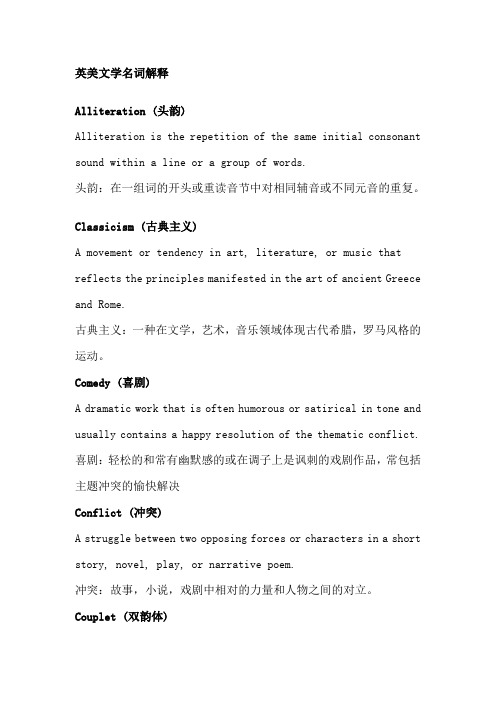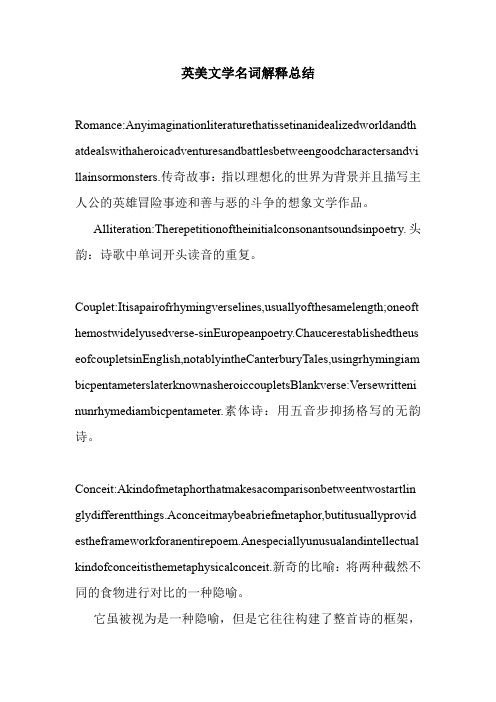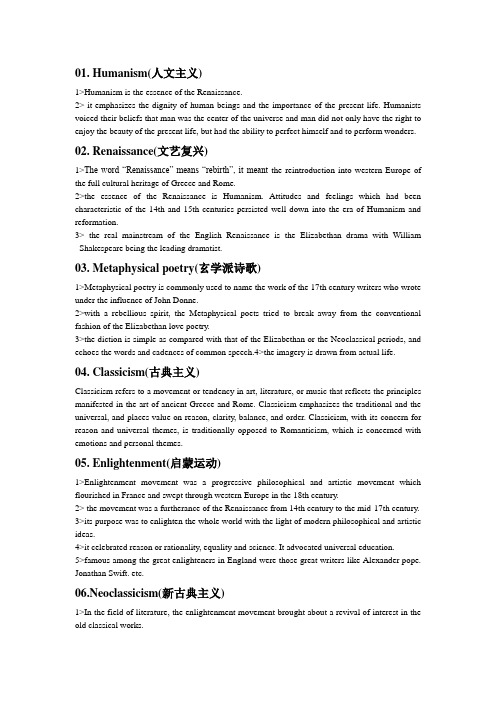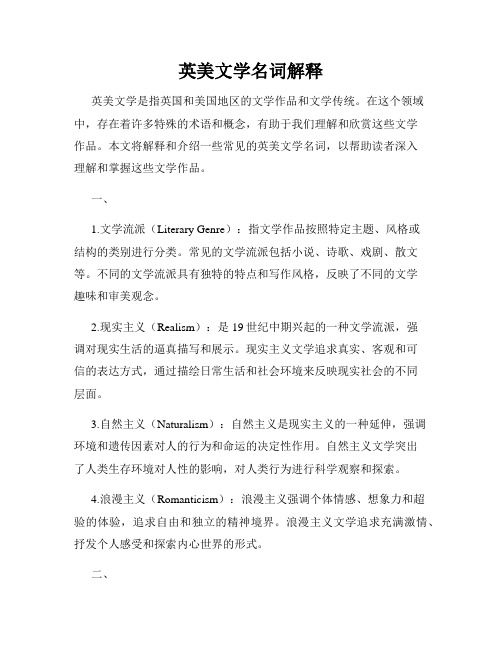英美文学名词解释
英美文学名词解释

英美文学名词解释Alliteration (头韵)Alliteration is the repetition of the same initial consonant sound within a line or a group of words.头韵:在一组词的开头或重读音节中对相同辅音或不同元音的重复。
Classicism (古典主义)A movement or tendency in art, literature, or music that reflects the principles manifested in the art of ancient Greece and Rome.古典主义:一种在文学,艺术,音乐领域体现古代希腊,罗马风格的运动。
Comedy (喜剧)A dramatic work that is often humorous or satirical in tone and usually contains a happy resolution of the thematic conflict. 喜剧:轻松的和常有幽默感的或在调子上是讽刺的戏剧作品,常包括主题冲突的愉快解决Conflict (冲突)A struggle between two opposing forces or characters in a short story, novel, play, or narrative poem.冲突:故事,小说,戏剧中相对的力量和人物之间的对立。
Couplet (双韵体)A unit of verse consisting of two successive lines, usually rhyming and having the same meter and often forming a complete thought or syntactic unit.双韵体:包括两个相连的诗行的一种诗的单位,通常压韵并具有同样的格律,经常组成一个完整的意思和句法单位Heroic couplet (英雄双韵体)A couplet written in iambic pentameter is called a heroic couplet.英雄双韵体:五步抑扬格的双韵体称英雄双韵体。
英美文学名词解释总结.doc

英美文学名词解释总结Romance:Anyimaginationliteraturethatissetinanidealizedworldandth atdealswithaheroicadventuresandbattlesbetweengoodcharactersandvi llainsormonsters.传奇故事:指以理想化的世界为背景并且描写主人公的英雄冒险事迹和善与恶的斗争的想象文学作品。
Alliteration:Therepetitionoftheinitialconsonantsoundsinpoetry.头韵:诗歌中单词开头读音的重复。
Couplet:Itisapairofrhymingverselines,usuallyofthesamelength;oneoft hemostwidelyusedverse-sinEuropeanpoetry.Chaucerestablishedtheus eofcoupletsinEnglish,notablyintheCanterburyTales,usingrhymingiam bicpentameterslaterknownasheroiccoupletsBlankverse:Versewritteni nunrhymediambicpentameter.素体诗:用五音步抑扬格写的无韵诗。
Conceit:Akindofmetaphorthatmakesacomparisonbetweentwostartlin glydifferentthings.Aconceitmaybeabriefmetaphor,butitusuallyprovid estheframeworkforanentirepoem.Anespeciallyunusualandintellectual kindofconceitisthemetaphysicalconceit.新奇的比喻:将两种截然不同的食物进行对比的一种隐喻。
英美文学 名词整理

英国文学史名词解释Ode 颂诗is adignified and elaborately structured lyric poem of some length, praising and glorifying an individual, commemorating an event or describing nature intellectually rather than emotionally.Elegy挽歌: it seeks for "lament". It is a poem on death or on a serious loss; characteristically a sustained meditation expressing sorrow and, frequently, an explicit or implied consolation Anapset短短长格: a metrical foot of three syllables, the first two short, the last longCaesura 停顿a break or pause in a line of poetry, dictated by the natural rhythm of the language and sometimes enforced by punctuation.Epic史诗:It’s a long narrative poem celebrating the great deeds of one or more legendary heroes, majestic in theme and style.Romance 传奇a type of literature that was popular in the Middle Ages, usually containing adventures and reflecting the spirit of chivalry. Sir Gawain and the Green Knight was a great verse romance, but its author remains unknown.Alliteration押头韵is the use in speech or writing of several words close together that all begin with the same letter or sound.Ballad民谣: It is a story in poetic form, often about tragic love and usually sung. Ballads were passed down from generation to generation by singers. The medieval ballads are ballads of Robin Hood. Coleridge’s "The Rime of the Ancient Mariner" is a 19th century English ballad.Heroic couplet英雄体: They are poetry composed in iambic pentameter. In this form of poetry, lines consisting of five iambic feet rime together in pairs. The rime scheme :aa bb cc …..poet’s corner 诗人角a part of Westminster Abbey, London, which contains the tombs or monuments of some famous English poets, such as Geoffrey Chaucer and John Milton. Renaissance文艺复兴: Renaissance marks the transition from the medieval to the modern world. It first started in Italy in the 14th century and gradually spread all over Europe. The word “Renaissance” means rebirth or revival.Sonnet十四行诗: A lyric poem of fourteen lines whose ryhme scheme is fixed. The rhyme scheme in the Italian form as typified in the sonnets of Petrarch is abbaabba cdecde.Blank verse无韵诗: A poem written in unrhymed iambic pentameter.Spenserian Stanza斯宾塞诗体: It’s a verse from that consists of eight iambic pentameter lines followed by a ninth line of six iambic feet, with the rhyme scheme ababbbccdd.Enlightenment启蒙运动: The Enlightenment was a progressive intellectual movement throughout Western Europe in the 18th century. It was an expression of struggle of the bourgeoisie against feudalism.Sentimentalism感伤主义: Sentimentalism appeared in the middle of the 18th century, as a reaction against commercialism and the cold rationalism.Pre-romanticism:前浪漫主义 The Romantic Movement was marked by a strong protest against the bondage of Classicism, by a renewed interest in medieval literature.----representatives ---William Blake and Robert BurnsRomanticism浪漫主义 : Romanticism was in effect a revolt of the English imagination against the neoclassical reason, which prevailed from the days of Pope to those of Johnson.Neo-classicism新古典主义: A revival in the seventeenth and eighteenth centuries of classical standards of order, balance and harmony in literature.Elegy挽歌: it seeks for "lament". It is a poem on death or on a serious loss; characteristically asustained meditation expressing sorrow and, frequently, an explicit or implied consolation Realism现实主义: A term used in literature and art to present life as it really is without sentimentalizing or idealizing it.Epigram诙谐短诗:an epigram is a brief, celver, and usually memorable statement.Allegory寓言: A story illustrating an idea or a moral principle in which objects take on symbolic meanings.Lake Poets湖畔诗人: Wordsworth, Coleridge and Southey have often been mentioned as the "Lake Poets" because they lived in the lake district in the northwestern part of England. The three traversed the same path in politics and in poetry, beginning as radicals and closing as conservatives.Metaphysical Poetry玄学派诗歌: is characterized by verbal wit and excess, ingenious structure, irregular meter, colloquial language, elaborates imagery, and a drawing together of dissimilar ideas.Humanism人文主义: it refers to the main literary trend and is the keynote of English Renaissance. Humanists took interest in human life and human activities and gave expression to the new feeling of admiration for human beauty, human achievement.Mystery play神秘剧: The Mystery plays of the Middle Ages were based on the bible and were particularly concerned with the stories of man’s creation, Fall and Redemption.Iambic Pentamete r五音步抑扬格: A poetic line consisting of five verse feet, which each foot an iamb__ that is, an unstressed syllable followed by a stressed one. Iambic pentameter is the most common verse line in English poetry.Anapaest抑抑扬格:An anapaest, or anapest, also called antidactylus, is a metrical foot used in formal poetry. In classical quantitative meters it consists of two short syllables followed by a long one in accentual stress meters it consists of two unstressed syllables followed by one stressed syllable.Lyric 抒情诗: A poem, brief and discontinuous, emphasizes sound and pictorial imagery rather than narrative or dramatic movement.Byronic hero拜伦式英雄: is an idealized but flawed character exemplified in the life and writings of Lord Byron.Stream of consciousness意识流: a kind of writing technique in which a character's perceptions, thoughts, and memories are presented in an apparently random form, without regard for logical sequence, chronology, or syntax.Naturalism自然主义:A literary movement seeking to depict life as accurately as possible, without artificial distortions of emotion, idealism, and literary convention. It asserts that human beings exist entirely in the order of nature.Essay小说:is a short written composition that discusses a subject or proposes an argument without claiming to be a complete or thorough exposition.Gothic novel 哥德式小说:a story of terror and suspense, usually set in a gloomy old castle or monastery.Stanza 节: a division of a poem consisting of a series of lines arranged together in a recurring pattern of meter and rhyme.legend 传奇:As a song or a narrative handed down from the past, it differs from the myth on the basis of the elements of historical truth it containsCritical realism批判现实主义: is a term applied to the realistic fiction in the late 19th and early20th centuries.Iamb抑扬格韵律: a metrical foot consisting of two syllables, a short one followed by a long one kenning 隐喻语 a metaphor usually composed of two words and used for description and association.poet laureate 桂冠诗人A poet honored for his artistic achievement or selected as most representative of his country or era;Symbolism (象征主义)works under the surface to tie the story’s external action to the theme. It was often produced thr ough allegory, giving the literal event and its allegorical counterpart a one-to-one correspondence The Heroic Couplet(英雄对偶句):1)It means a pair of lines of a type once common in English poetry, in other words, it means iambic pentameter rhymed in two lines. 2)The rhyme is masculine. 3)Use of the heroic couplet w as first pioneered by Geoffrey Chaucer.Modernism现代主义is marked by a rejection of tradition, and an interest in new ways of doing old things. Also, there was a belief that the application of science and technology could change the world for the better.8)William Blake ( 1757—1827)1) LifeHe lived into the 19th century. In his lifetime, he was not considered a very important poet. Now he is universally acknowledged as one of the most important poets in English literature. His father recognized his talent and sent him to school.His visionary梦想的experience:Classicism典范: reason, order, law, art techniquesHe believed the power of imagination. With it a poet can reach out. Blake and Burns彭斯—the romantic revival复活—to break away with the convention习俗,协议2) His workSongs of Innocence天真之歌→delightSongs of Experience经验之歌→confusion困惑They show two contrary states of human soulsLondon:I wander thro’ each charter’d street, near where the ….It is taken from The Songs of Experience. Blake apparently drew from his personal observations and gives a comprehensive综合的picture of the many miseries, physical and spiritual, in the English capital.资本家Background: industrial revolution, the fog cityThe scene was in London, in Blake’s time.The Tiger:tiger!tiger!burning bright in the forests of the night…..It is from The Songs of Experience. It is one of Blake’s be st known poems. The apparently simple questions of curiosity and puzzlement. What imagination inspires the creator1.The image of the maker is complete. the process of creating tiger.Religions allusion暗指: lamb羊羔The whole poem is consisted of questions—are not able to be answeredThe Chimney-Sweeper扫烟囱的孩子:a little black thing among the snow cring” weep, weep” in notes of woe!The short lyric contains chiefly the simple yet somewhat ironical speech of a boy chimney9 ) Robert Burns罗伯特。
(完整版)英美文学名词解释最全版

01. Humanism(人文主义)1>Humanism is the essence of the Renaissance.2> it emphasizes the dignity of human beings and the importance of the present life. Humanists voiced their beliefs that man was the center of the universe and man did not only have the right to enjoy the beauty of the present life, but had the ability to perfect himself and to perform wonders.02. Renaissance(文艺复兴)1>The word “Renaissance”means “rebirth”, it meant the reintroduction into western Europe of the full cultural heritage of Greece and Rome.2>the essence of the Renaissance is Humanism. Attitudes and feelings which had been characteristic of the 14th and 15th centuries persisted well down into the era of Humanism and reformation.3> the real mainstream of the English Renaissance is the Elizabethan drama with William Shakespeare being the leading dramatist.03. Metaphysical poetry(玄学派诗歌)1>Metaphysical poetry is commonly used to name the work of the 17th century writers who wrote under the influence of John Donne.2>with a rebellious spirit, the Metaphysical poets tried to break away from the conventional fashion of the Elizabethan love poetry.3>the diction is simple as compared with that of the Elizabethan or the Neoclassical periods, and echoes the words and cadences of common speech.4>the imagery is drawn from actual life.04. Classicism(古典主义)Classicism refers to a movement or tendency in art, literature, or music that reflects the principles manifested in the art of ancient Greece and Rome. Classicism emphasizes the traditional and the universal, and places value on reason, clarity, balance, and order. Classicism, with its concern for reason and universal themes, is traditionally opposed to Romanticism, which is concerned with emotions and personal themes.05. Enlightenment(启蒙运动)1>Enlightenment movement was a progressive philosophical and artistic movement which flourished in France and swept through western Europe in the 18th century.2> the movement was a furtherance of the Renaissance from 14th century to the mid-17th century.3>its purpose was to enlighten the whole world with the light of modern philosophical and artistic ideas.4>it celebrated reason or rationality, equality and science. It advocated universal education.5>famous among the great enlighteners in England were those great writers like Alexander pope. Jonathan Swift. etc.06.Neoclassicism(新古典主义)1>In the field of literature, the enlightenment movement brought about a revival of interest in the old classical works.2>this tendency is known as neoclassicism. The Neoclassicists held that forms of literature were to be modeled after the classical works of the ancient Greek and Roman writers such as Homer and Virgil and those of the contemporary French ones.3> they believed that the artistic ideals should be order, logic, restrained emotion and accuracy, and that literature should be judged in terms of its service to humanity.07. The Graveyard School(墓地派诗歌)1>The Graveyard School refers to a school of poets of the 18th century whose poems are mostly devoted to a sentimental lamentation or meditation on life. Past and present ,with death and graveyard as themes.2>Thomas Gray is considered to be the leading figure of this school and his Elegy written in a country churchyard is its most representative work.08. Romanticism(浪漫主义)1>In the mid-18th century, a new literary movement called romanticism came to Europe and then to England.2>It was characterized by a strong protest against the bondage of neoclassicism, which emphasized reason, order and elegant wit. Instead, romanticism gave primary concern to passion, emotion, and natural beauty.3>In the history of literature. Romanticism is generally regarded as the thought that designates a literary and philosophical theory which tends to see the individual as the very center of all life and experience. 4> The English romantic period is an age of poetry which prevailed in England from 1798 to 1837. The major romantic poets include Wordsworth, Byron and Shelley.09. Byronic Hero(拜伦式英雄)1>Byronic hero refers to a proud, mysterious rebel figure of noble origin.2> with immense superiority in his passions and powers, this Byronic Hero would carry on his shoulders the burden of righting all the wrongs in a corrupt society. And would rise single-handedly against any kind of tyrannical rules either in government, in religion, or in moral principles with unconquerable wills and inexhaustible energies.3> Byron’s chief contribution to English literature is his creation of the “Byronic Hero”10. Critical Realism(批判现实主义)1>Critical Realism is a term applied to the realistic fiction in the late 19th and early 20th centuries.2> It means the tendency of writers and intellectuals in the period between 1875 and 1920 to apply the methods of realistic fiction to the criticism of society and the examination of social issues.3> Realist writers were all concerned about the fate of the common people and described what was faithful to reality.4> Charles Dickens is the most important critical realist.11. Aestheticism(美学主义)1>The basic theory of the Aesthetic movement--- “art for art’s sake” was set forth by a French poet, Theophile Gautier, the first Englishman who wrote about the theory of aestheticism was Walter Pater.2> aestheticism places art above life, and holds that life should imitate art, not art imitate life.3> According to the aesthetes, all artistic creation is absolutely subjective as opposed to objective. Art should be free from any influence of egoism. Only when art is for art’s sake, can it be immortal. They believed that art should be unconcerned with controversial issues, such as politics and morality, and that it should be restricted to contributing beauty in a highly polished style.4> This is one of the reactions against the materialism and commercialism of the Victorian industrial era, as well as a reaction against the Victorian convention of art for morality’s sake, or art for money’s sake.美学运动的基本原则”为艺术而艺术”最初由法国诗人西奥费尔.高缔尔提出,英国运用该美学理论的第一人是沃尔特.佩特.美学主义崇尚艺术高于生活,认为生活应模仿艺术,而不是艺术模仿生活.在美学主义看来,所有的艺术创作都是绝对主观而非客观的产物.艺术不应受任何功利的影响,只有当艺术为艺术而创作时,艺术才能成为不朽之作.他们还认为艺术不应只关注一些热点话题如政治和道德问题,艺术应着力于以华丽的风格张扬美.这是对维多利亚工业发展时期物质崇拜的一种回应,也是向艺术为道德或为金钱而服务的维多利亚传统的挑战.12.The Victorian period(维多利亚时期)1>In this period, the novel became the most widely read and the most vital and challenging expression of progressive thought. While sticking to the principle of faithful representation of the 18th century realist novel, novelists in this period carried their duty forward to criticism of the society and the defense of the mass.2> although writing from different points of view and with different techniques, they shared one thing in common, that is, they were all concerned about the fate of the common people. They were angry with the inhuman social institutions, the decaying social morality as represented by the money-worship and Utilitarianism, and the widespread misery, poverty and injustice.3>their truthful picture of people’s life and bitter and strong criticism of the society had done much in awakening the public consciousness to the social problems and in the actual improvement of the society.4> Charles Dickens is the leading figure of the Victorian period.13. Modernism(现代主义)1>Modernism is comprehensive but vague term for a movement , which begin in the late 19th century and which has had a wide influence internationally during much of the 20th century.2> modernism takes the irrational philosophy and the theory of psycho-analysis as its theoretical case.3> the term pertains to all the creative arts. Especially poetry, fiction, drama, painting, music and architecture.4> in England from early in the 20th century and during the 1920s and 1930s, in America from shortly before the first world war and on during the inter-war period, modernist tendencies were at their most active and fruitful.5>as far as literature is concerned, Modernism reveals a breaking away from established rules, traditions and conventions. fresh ways of looki ng at man’s position and function in the universe and many experiments in form and style. It is particularly concerned with language and how to use it and with writing itself.14. Stream of consciousness(意识流)(or interior monologue)In literary criticism, Stream of consciousness denotes a literary technique which seeks to describe an individual’s point of view by giving the written equivalent of the character’s thought processes. Stream of consciousness writing is strongly associated with the modernist movement. Its introduction in the literary context, transferred from psychology, is attributed to May Sinclair. Stream of consciousness writing is usually regarded as a special form of interior monologue and is characterized by associative leaps in syntax and punctuation that can make the prose difficult to follow, tracing as they do a character’s fragmentary thoughts and sensory feelings. Famous writers to employ this technique in the English language include James Joyce and William Faulkner.学术界认为意识流是一种通过直接描述人物思维过程来寻求个人视角的文学写作技巧。
(完整word版)英美文学名词解释总结中文版(东北师大重点)

名词解释1. Abby Theatre 阿贝剧院阿贝剧院是爱尔兰的国家剧院,由爱尔兰著名诗人William Butler Yeats和Lady Augusta Gregory创建。
该剧院上演爱尔兰剧作家的作品。
Lady Gregory是阿贝剧院的导演,同时也是个剧作家(dramatist)。
2。
Aestheticism 唯美主义基本原则:Art for art’s sake.基本人物:英国运用该美学理论的第一人士Walter Pater。
Oscar Wilder(Picture of Dorian Gray)是该理论的杰出代表。
基本思想:唯美主义崇尚艺术高于生活,生活应该模仿艺术,而不是艺术模仿生活。
这是对Victorian工业发展时期宣扬的物质崇拜(materialism)和商业主义(commercialism)的一种反抗,也是艺术为道德或金钱而服务(art for money’s sake)的维多利亚传统的挑战。
3. Age of Enlightenment 启蒙时代1. 英国的18世纪又被称为启蒙时代,总的来说是资本主义反对封建主义的时代.2. 启蒙运动是一场进步的思想运动,盛行于法国后传播到西欧。
3. 启蒙运动是15和16世界文艺复兴运动的延续和深入,它的目的是用现代哲学和艺术观点启蒙整个世界.4。
崇尚理性,平等,和科学,倡导大众教育。
文学在当时变成了非常受欢迎的公众教育的手段,带有强烈的说教和道德教育性质。
5. 代表人物:Alexander Pope,Jonathan Swift.4. Age of Realism现实主义时期1。
现实主义是对浪漫主义时期一种反抗,并铺就了通往现代主义文学的道路。
2。
在这一时期,新一代的作家对于老一辈的浪漫主义和感伤主义的思想非常不满,提出一个新的灵感,其特点就是在生活现实方面有着极大的兴趣.它的目标是描写生活每一方面的现实,抛弃主观偏见,理想主义或者任何浪漫的色彩。
英美文学名词解释

英美文学名词解释英美文学是指英国和美国地区的文学作品和文学传统。
在这个领域中,存在着许多特殊的术语和概念,有助于我们理解和欣赏这些文学作品。
本文将解释和介绍一些常见的英美文学名词,以帮助读者深入理解和掌握这些文学作品。
一、1.文学流派(Literary Genre):指文学作品按照特定主题、风格或结构的类别进行分类。
常见的文学流派包括小说、诗歌、戏剧、散文等。
不同的文学流派具有独特的特点和写作风格,反映了不同的文学趣味和审美观念。
2.现实主义(Realism):是19世纪中期兴起的一种文学流派,强调对现实生活的逼真描写和展示。
现实主义文学追求真实、客观和可信的表达方式,通过描绘日常生活和社会环境来反映现实社会的不同层面。
3.自然主义(Naturalism):自然主义是现实主义的一种延伸,强调环境和遗传因素对人的行为和命运的决定性作用。
自然主义文学突出了人类生存环境对人性的影响,对人类行为进行科学观察和探索。
4.浪漫主义(Romanticism):浪漫主义强调个体情感、想象力和超验的体验,追求自由和独立的精神境界。
浪漫主义文学追求充满激情、抒发个人感受和探索内心世界的形式。
二、1.象征主义(Symbolism):象征主义是19世纪末20世纪初出现的一种文学和艺术运动,强调使用象征性的意象和隐喻来表达深层的情感和思想。
象征主义文学倾向于表达个体的情感体验和心灵探索。
2.现代主义(Modernism):现代主义是20世纪初兴起的一种文学和艺术运动,强调对传统形式和观念的挑战和颠覆。
现代主义文学追求形式上的创新和实验,探索自我意识、哲学思考和社会变革。
3.后现代主义(Postmodernism):后现代主义是现代主义的继承和超越,强调文化多样性、相对主义和戏仿。
后现代主义文学打破传统的叙事和结构规则,以戏仿和颠覆的方式探索权力、真实性和历史观念。
4.现实主义小说(Realistic Novel):现实主义小说以真实的描写和社会批判为特征,通过塑造现实人物的经历和命运来反映社会问题。
英美文学名词解释
1.古英语:(Old English或Anglo-Saxon)是指从450年到1150年间的英语。
古英语和现代英语无论在读音、拼写、词汇和语法上都很不一样。
古英语的语法和德语比较相近,形态变化很复杂。
公元410年,罗马人结束了对英国的占领,随后,来自德国北部平原的三个日耳曼部落:昂格鲁人(Angles),撒克逊人,和朱尔特人开始到不列颠定居.英语就是盎格鲁_撒克逊的人的语言.语言史家一般把英语的历史分为三个时期:古英语,中英语,现代英语.古英语的名词有数和格的分别。
数分为单数、复数;格分为主格、所有格、与格、宾格。
因此一个名词加起来共有8种变化形式。
此外,名词还分阳性、中性和阴性。
但是比较奇怪的是,这些性的区分并不是以性别来判断的,而且没有性别的事物也未必是中性。
例如妇女就是阳性的。
2. 头韵(Alliteration):是英语语言学分支文体学的重要术语。
头韵是英语语音修辞手段之一,它蕴含了语言的音乐美和整齐美,使得语言声情交融、音义一体,具有很强的表现力和感染力.从应用范围、结构特征以及审美价值三个方面对其进行分析讨论,将有助于我们理解和欣赏这一辞格. 头韵在英语里叫alliteration,又叫initial rhyme,或head rhyme,是从拉丁语短语ad literam (根据字母)转化而来的,指两个单词或两个单词以上的首字母相同,形成悦耳的读音,最常见的押头韵的短语有:first and foremost(首先)、(with)might and main (尽全力地)、saints and sinners (圣人与罪人)、(in)weal and (or) woe(无论是福是祸)。
若追本探源的话,恐怕押头韵手法可以上溯到古英语(Old English)时期。
大约五世纪时,盎格鲁萨克逊( Anglo-Saxons)入侵者给英国人带来了作为现代英语(Modern English)基础的盎格鲁萨克逊语,或许就在那时还带来一种新的诗歌形式,其主要特征就是频繁使用押头韵手法。
英美文学名词解释
1 Alliteration (头韵)Alliteration is the repetition of the same initial consonant sound within a line or a group of words.头韵:在一组词的开头或重读音节中对相同辅音或不同元音的重复。
2. Ballad (民谣)A narrative poem, often of folk origin and intended to be sung3 Ballad Stanza (民谣诗节)A type of four-line stanza, the first and the third lines have four stressed words or syllables; the second and fourth lines have three stresses.3 Autobiography (自传)A person‘s account of his or her own life.4. Biography (传记)A detailed account of a person‘s life written by another person.传记:由他人篆写的关于某人生平的详细记录。
5. Classicism (古典主义)A movement or tendency in art, literature, or music that reflects the principles manifested in the art of ancient Greece and Rome.古典主义:一种在文学,艺术,音乐领域体现古代希腊,罗马风格的运动。
6. Comedy (喜剧)A dramatic work that is often humorous or satirical in tone and usuallycontains a happy resolution of the thematic conflict.喜剧:轻松的和常有幽默感的或在调子上是讽刺的戏剧作品,常包括主题冲突的愉快解决7. Conflict (冲突)A struggle between two opposing forces or characters in a short story, novel, play, or narrative poem.冲突:故事,小说,戏剧中相对的力量和人物之间的对立。
英美文学名词解释总结
Romance: Any imagination literature that is set in an idealized world and that deals with a heroic adventures and battles between good characters and villains or monsters.传奇故事:指以理想化的世界为背景并且描写主人公的英雄冒险事迹和善与恶的斗争的想象文学作品。
Alliteration: The repetition of the initial consonant sounds in poetry.头韵:诗歌中单词开头读音的重复。
Couplet: It is a pair of rhyming verse lines, usually of the same length; one of the most widely used verse-forms in European poetry. Chaucer established the use of couplets in English, notably in the Canterbury Tales, using rhyming iambic pentameters later known as heroic coupletsBlank verse: Verse written in unrhymed iambic pentameter.素体诗:用五音步抑扬格写的无韵诗。
Conceit: A kind of metaphor that makes a comparison between two startlingly different things. A conceit may be a brief metaphor, but it usually provides the framework for an entire poem. An especially unusual and intellectual kind of conceit is the metaphysical conceit.新奇的比喻:将两种截然不同的食物进行对比的一种隐喻。
环球英美文学名词解释
环球英美文学名词解释
环球英美文学是指涉及英国和美国文学的范畴,包括了从古代到现代的各种文学作品和文学运动。
下面是一些环球英美文学中常见的名词解释:
1. 小说(Novel),一种长篇故事性散文作品,通常包含复杂的情节、丰富的人物描写和深入的主题探讨。
2. 诗歌(Poetry),一种以韵律、节奏和意象为特征的文学形式,通过语言的美感表达情感和思想。
3. 戏剧(Drama),一种通过对话和行动来呈现故事的文学形式,通常在舞台上演出。
4. 文学运动(Literary Movement),指在特定的时期和地域中出现的一系列文学作品和思潮,代表了一种共同的艺术追求和创作风格,如文艺复兴、浪漫主义、现代主义等。
5. 符号主义(Symbolism),19世纪末至20世纪初的一种文学运动,强调象征和隐喻的使用,追求超越直接表达的意义。
6. 现实主义(Realism),19世纪中期兴起的一种文学运动,试图以客观真实的方式描绘社会生活,关注社会问题和人性。
7. 自然主义(Naturalism),19世纪末的一种文学运动,强调环境和遗传对人性的影响,揭示社会底层的艰苦生活和人类的本性。
8. 象征主义(Imagism),20世纪初的一种文学运动,追求简洁、直接和精确的语言,注重意象和感官经验的表达。
9. 后现代主义(Postmodernism),20世纪后半叶兴起的一种文学思潮,挑战传统的叙事结构和真实性,强调多元性、相对性和模糊性。
以上仅是环球英美文学中一些常见名词的简要解释,实际上还有许多其他的名词和概念需要深入研究和理解。
- 1、下载文档前请自行甄别文档内容的完整性,平台不提供额外的编辑、内容补充、找答案等附加服务。
- 2、"仅部分预览"的文档,不可在线预览部分如存在完整性等问题,可反馈申请退款(可完整预览的文档不适用该条件!)。
- 3、如文档侵犯您的权益,请联系客服反馈,我们会尽快为您处理(人工客服工作时间:9:00-18:30)。
1. epic(史诗)Epic, in poetry, refers to a long work dealing with the actions of goods and heroes.2>Epic poems are not merely entertaining stories of legendary or historical heroes; they summarize and express the nature or ideals of an entire nation at a significant or crucial period of its history.3>Beowulf is the greatest national Epic of the Anglo-Saxons.2. Sonnet(十四行诗)It is a lyric poem of 14 lines with a formal or recited and characterized by its presentation of a dramatic or exciting episode in simple narrative form.2>it is one of the most conventional and influential forms of poetry in Europe.3>Shakespeare’s sonnets are well-known.3. Blank V erse(无韵诗或素体广义地说)Blank verse is unrhymed poetry. Typically in iambic pentameter, and as such, the dominant verse forms of English dramatic and narrative poetry since the mid-16th century.4. Renaissance(文艺复兴)The word “Renaissance”means “rebirth”, it meant the reintroduction into westerm Europe of the full cultural heritage of Greece and Rome.2>the essence of the Renaissance is Humanism. Attitudes and feelings which had been characteristic of the 14th and 15th centuries persisted well down into the era of Humanism and reformation.3> the real mainstream of the English Renaissance is the Elizabethan drama with William Shakespeare being the leading dramatist.5. Neoclassicism(新古典主义)In the field of literature, the enlightenment movement brought about a revival of interest in the old classical works.2>this tendency is known as neoclassicism. The Neoclassicists held that forms of literature were to be modeled after the classical works of the ancient Greek and Roman writers such as Homer and Virgil and those of the contemporary French ones.3> they believed that the artistic ideals should be order, logic, restrained emotion and accuracy, and that literature should be judged in terms of its service to humanity.6. Sentimentalism(感伤主义文学)Sentimentalism is a pejorative term to describe false or superficial emotion, assumed feeling, self-regarding postures of grief and pain,2> in literature it denotes overmuch use of pathetic effects and attempts to arouse feeling by “pathetic” indu lgence.7. Romanticism(浪漫主义)1>In the mid-18th century, a new literary movement called romanticism came toEurope and then to England.2>It was characterized by a strong protest against the bondage of neoclassicism, which emphasized reason, order and elegant wit. Instead, romanticism gave primary concern to passion, emotion, and natural beauty.3>In the history of literature. Romanticism is generally regarded as the thought that designates a literary and philosophical theory which tends to see the individ ual as the very center of all life and experience. 4> The English romantic period is an age of poetry which prevailed in England from 1798 to 1837. The major romantic poets include Wordsworth, Byron and Shelley.8. Gothic novel(哥特式小说)Gothic novel is a type of romance very popular late in the 18th century and at the beginning of the 19th century.2> Gothic novel emphasizes things which are grotesque, violent, mysterious, supernatural, desolate and horrifying.3> Gothic, originally in the sense of “medic,not classical”, with its descriptions of the dark, irrational side of human nature, Gothic novel has exerted a great influence over the writers of the Romantic period.9. NarrationIt is a synonym for story-telling. 2> in fiction, narrative passages are to be distinguished from descriptions and scenes, in narrative passages the chronology is condensed so that relatively few words will encompass the events of an extended period of time. Most writers use narrative passages to fill in the links between events. There were two types of narration, first-person narration and third-person narration. 10. Critical Realism(批判现实主义)Critical Realism is a term applied to the realistic fiction in the late 19th and early 20th centuries.2> It means the tendency of writers and intellectuals in the period between 1875 and 1920 to apply the methods of realistic fiction to the criticism of society and the examination of social issues.3> Realist writers were all concerned about the fate of the common people and described what was faithful to reality.4> Charles Dickens is the most important critical realist.。
